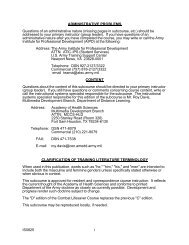MCWP-3-11.3-Scouting-and-Patrolling
MCWP-3-11.3-Scouting-and-Patrolling
MCWP-3-11.3-Scouting-and-Patrolling
You also want an ePaper? Increase the reach of your titles
YUMPU automatically turns print PDFs into web optimized ePapers that Google loves.
<strong>Scouting</strong> <strong>and</strong> <strong>Patrolling</strong> _________________________________________________________________________________ 11-3spoken into the microphone with h<strong>and</strong>s cupped over itin a low voice.Other sound signals may be used if the patrol leader issure they serve the purpose intended. Planned soundsignals are rehearsed before starting on the patrol.Sound signals used must be simple, natural sounds thatare few in number <strong>and</strong> easily understood. Bird <strong>and</strong>animal calls are seldom satisfactory.Infrared equipment, such as the sniper scope <strong>and</strong>infrared filters for the flashlight, may be used as meansof sending <strong>and</strong> receiving signals <strong>and</strong> maintainingcontrol at night.Luminous tape may be used to assist in control atnight. Small strips on the back of the cap or collar ofpatrol members aid in keeping visual contact with thefront member. However, the luminous tape must becovered when near the enemy.An important aspect of control is accounting ofpersonnel, especially after crossing danger areas,enemy contacts, halts, <strong>and</strong> exiting <strong>and</strong> re-enteringfriendly lines. The patrol leader may arrange for thelast member to send up the count automatically aftercrossing danger areas, enemy contact, <strong>and</strong> halts. Inlarge patrols or when moving in a formation other thana column, subordinate leaders check members <strong>and</strong>report the count to the patrol leader by the quickestmethod appropriate to the circumstances.NavigationOne or more members are assigned as navigators forthe patrol. Their function is to assist the patrol leaderin maintaining direction by the use of the compass.The patrol leader assigns at least two members aspacers to keep track of the distance from point topoint. The average of their count is used to approximatethe distance traveled. Pacers are separatedso they do not influence each other’s count. Pacersmust know how to convert their own paces to meters.The route is divided into increments, with eachincrement starting at a recognizable point on theground. The pacers begin their counts from zero at thebeginning of each leg. This makes the pace counteasier to keep <strong>and</strong> checks for accuracy.The pace count is sent forward when the patrol leaderturns to the member behind <strong>and</strong> in a low voice says,“send up the pace” or uses the arm-<strong>and</strong>-h<strong>and</strong> signal oftapping his boot. This signal is passed to both pacers,who in turn send up the pace count in meters; forexample, “two-hundred” or “one-seven-five.”Patrol members must underst<strong>and</strong> that the counts ofboth pacers are sent forward. The patrol leader mustknow the counts of both men in order to check them.SecurityThe patrol is dispersed consistent with control, visibility,cover, <strong>and</strong> concealment. Scouts are employed tothe front, flanks, <strong>and</strong> rear of the patrol to providesecurity. For the patrol members traveling in the mainbody of the patrol, areas of responsibility are assignedto the front, flanks, <strong>and</strong> rear. Scouts are the eyes <strong>and</strong>ears of the patrol leader. They move when <strong>and</strong> wheredirected by the patrol leader <strong>and</strong> maintain contact withthe patrol leader at all times, except when momentarilyobscured by vegetation or other terrain features.FrontSmall patrols (squad size) may employ from one scoutup to a fire team as the point, depending on the enemysituation, terrain, <strong>and</strong> route being followed by thepatrol. Normally, squad-size patrols will use twoscouts as the point. The point is responsible forinvestigating the route of advance immediately to thefront of the patrol.The point moves as far ahead of the patrol as visibility<strong>and</strong> terrain permit. When visibility is good, the pointmay precede the main body by as much as 100 meters.The point travels right <strong>and</strong> left ahead of the patrol,searching the area over which the patrol will pass.The point maintains direction by knowledge of thegeneral route to be followed <strong>and</strong> visual contact withthe patrol leader. The patrol leader or the navigatorensures that the point is proceeding correctly.The point, which stays far enough ahead of the patrolto provide security, is not a trail breaker for the patrol.If the point loses contact with the patrol, the pointwaits for the main body to catch up or moves rearwardif contact is not quickly regained.One of the navigators may be positioned with thepoint. One or more members works as the point whilethe other is the navigator.



